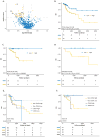Genome-wide Discovery and Identification of a Novel miRNA Signature for Recurrence Prediction in Stage II and III Colorectal Cancer
- PMID: 29514841
- PMCID: PMC6095767
- DOI: 10.1158/1078-0432.CCR-17-3236
Genome-wide Discovery and Identification of a Novel miRNA Signature for Recurrence Prediction in Stage II and III Colorectal Cancer
Abstract
Purpose: The current tumor-node-metastasis (TNM) staging system is inadequate at identifying patients with high-risk colorectal cancer. Using a systematic and comprehensive biomarker discovery and validation approach, we aimed to identify an miRNA recurrence classifier (MRC) that can improve upon the current TNM staging as well as is superior to currently offered molecular assays.Experimental Design: Three independent genome-wide miRNA expression profiling datasets were used for biomarker discovery (N = 158) and in silico validation (N = 109 and N = 40) to identify an miRNA signature for predicting tumor recurrence in patients with colorectal cancer. Subsequently, this signature was analytically trained and validated in retrospectively collected independent patient cohorts of fresh-frozen (N = 127, cohort 1) and formalin-fixed paraffin-embedded (FFPE; N = 165, cohort 2 and N = 139, cohort 3) specimens.Results: We identified an 8-miRNA signature that significantly predicted recurrence-free interval (RFI) in the discovery (P = 0.002) and two independent publicly available datasets (P = 0.00006 and P = 0.002). The RT-PCR-based validation in independent clinical cohorts revealed that MRC-derived high-risk patients succumb to significantly poor RFI in patients with stage II and III colorectal cancer [cohort 1: hazard ratio (HR), 3.44 (1.56-7.45), P = 0.001; cohort 2: HR, 6.15 (3.33-11.35), P = 0.001; and cohort 3: HR, 4.23 (2.26-7.92), P = 0.0003]. In multivariate analyses, MRC emerged as an independent predictor of tumor recurrence and achieved superior predictive accuracy over the currently available molecular assays. The RT-PCR-based MRC risk score = (-0.1218 × miR-744) + (-3.7142 × miR-429) + (-2.2051 × miR-362) + (3.0564 × miR-200b) + (2.4997 × miR-191) + (-0.0065 × miR-30c2) + (2.2224 × miR-30b) + (-1.1162 × miR-33a).Conclusions: This novel MRC is superior to currently used clinicopathologic features, as well as National Comprehensive Cancer Network (NCCN) criteria, and works regardless of adjuvant chemotherapy status in identifying patients with high-risk stage II and III colorectal cancer. This can be readily deployed in clinical practice with FFPE specimens for decision-making pending further model testing and validation. Clin Cancer Res; 24(16); 3867-77. ©2018 AACRSee related commentary by Rodriguez et al., p. 3787.
©2018 American Association for Cancer Research.
Conflict of interest statement
The author shave declared no conflict of interest
Figures




Comment in
-
Adjuvant Therapy for Colon Cancer: Genes, Genes… and the Patient in the Center.Clin Cancer Res. 2018 Aug 15;24(16):3787-3789. doi: 10.1158/1078-0432.CCR-18-0818. Epub 2018 Apr 20. Clin Cancer Res. 2018. PMID: 29678903
Similar articles
-
Genome-wide identification of a novel miRNA-based signature to predict recurrence in patients with gastric cancer.Mol Oncol. 2018 Dec;12(12):2072-2084. doi: 10.1002/1878-0261.12385. Epub 2018 Oct 10. Mol Oncol. 2018. PMID: 30242969 Free PMC article.
-
High expression of miR-181c as a predictive marker of recurrence in stage II colorectal cancer.Oncotarget. 2017 Jan 24;8(4):6970-6983. doi: 10.18632/oncotarget.14344. Oncotarget. 2017. PMID: 28036302 Free PMC article.
-
A formalin-fixed paraffin-embedded (FFPE)-based prognostic signature to predict metastasis in clinically low risk stage I/II microsatellite stable colorectal cancer.Cancer Lett. 2017 Sep 10;403:13-20. doi: 10.1016/j.canlet.2017.05.031. Epub 2017 Jun 15. Cancer Lett. 2017. PMID: 28624625
-
Primary tumor microRNA signature predicts recurrence and survival in patients with locally advanced esophageal adenocarcinoma.Oncotarget. 2016 Dec 6;7(49):81281-81291. doi: 10.18632/oncotarget.12832. Oncotarget. 2016. PMID: 27793030 Free PMC article. Review.
-
Stromal expression of miR-21 in T3-4a colorectal cancer is an independent predictor of early tumor relapse.BMC Gastroenterol. 2015 Jan 22;15:2. doi: 10.1186/s12876-015-0227-0. BMC Gastroenterol. 2015. PMID: 25609245 Free PMC article. Review.
Cited by
-
Role of microRNA-33a in malignant cells.Oncol Lett. 2020 Sep;20(3):2537-2556. doi: 10.3892/ol.2020.11835. Epub 2020 Jul 9. Oncol Lett. 2020. PMID: 32782572 Free PMC article. Review.
-
DeepCC: a novel deep learning-based framework for cancer molecular subtype classification.Oncogenesis. 2019 Aug 16;8(9):44. doi: 10.1038/s41389-019-0157-8. Oncogenesis. 2019. PMID: 31420533 Free PMC article.
-
Integrated Analysis Identifies a Nine-microRNA Signature Biomarker for Diagnosis and Prognosis in Colorectal Cancer.Front Genet. 2020 Mar 20;11:192. doi: 10.3389/fgene.2020.00192. eCollection 2020. Front Genet. 2020. PMID: 32265979 Free PMC article.
-
Prognostic Value of MicroRNAs in Stage II Colorectal Cancer Patients: A Systematic Review and Meta-Analysis.Mol Diagn Ther. 2020 Feb;24(1):15-30. doi: 10.1007/s40291-019-00440-y. Mol Diagn Ther. 2020. PMID: 32020560
-
Multi-Size Deep Learning Based Preoperative Computed Tomography Signature for Prognosis Prediction of Colorectal Cancer.Front Genet. 2022 May 12;13:880093. doi: 10.3389/fgene.2022.880093. eCollection 2022. Front Genet. 2022. PMID: 35646105 Free PMC article.
References
Publication types
MeSH terms
Substances
Grants and funding
LinkOut - more resources
Full Text Sources
Other Literature Sources
Medical

